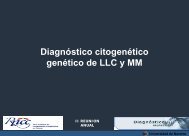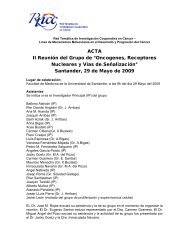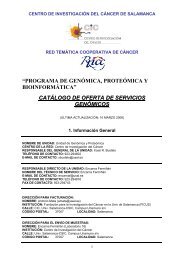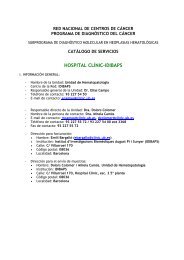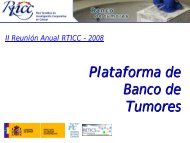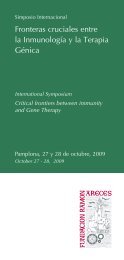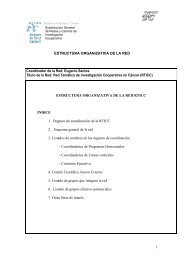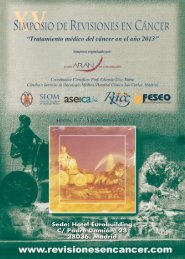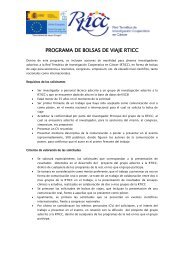Untitled - Red Temática de investigación cooperativa en cáncer
Untitled - Red Temática de investigación cooperativa en cáncer
Untitled - Red Temática de investigación cooperativa en cáncer
You also want an ePaper? Increase the reach of your titles
YUMPU automatically turns print PDFs into web optimized ePapers that Google loves.
P-43<br />
ESTUDIO DE CAMBIOS FOCALES EN EL NÚMERO DE COPIAS DE DNA EN<br />
NEUROBLASTOMA MEDIANTE ARRAYS DE SNP<br />
BERBEGALL BELTRÁN AP 1 , VILLAMÓN RIBATE E 1 , TADEO CERVERA I 2 , MARTA PIQUERAS 1 , NAVA-<br />
RRO FOS S 1 , NOGUERA SALVÁ R 1<br />
1<br />
FACULTAD DE MEDICINA –UNIVERSIDAD DE VALENCIA, VALENCIA (RD06/0020/0102)<br />
2<br />
FUNDACIÓN DE INVESTIGACIÓN DEL HOSPITAL CLÍNICO DE VALENCIA, VALENCIA (RD06/0020/0102)<br />
Introducción: El neuroblastoma (NB) es el tumor sólido extracraneal más frecu<strong>en</strong>te <strong>en</strong><br />
la infancia. G<strong>en</strong>éticam<strong>en</strong>te es frecu<strong>en</strong>te observar cambios numéricos cromosómicos completos<br />
(NCA) y gran<strong>de</strong>s alteraciones cromosómicas segm<strong>en</strong>tarias (SCA). La importancia<br />
pronóstica <strong>de</strong> estos cambios no ha facilitado el estudio <strong>de</strong> las SCA focales (≤ 2 Mb).<br />
Material y Métodos: Hemos analizado 145 NBs mediante arrays <strong>de</strong> SNP (Affymetrix 250K<br />
y/o Illumina 300K). Junto con la <strong>de</strong>scripción <strong>de</strong> los perfiles pang<strong>en</strong>ómicos típicos (NCA y<br />
SCA) realizamos un estudio preliminar sobre la pres<strong>en</strong>cia y tipo <strong>de</strong> ganancias, amplificaciones<br />
y/o pérdidas cromosómicas focales.<br />
Resultados: En todos los tumores analizados observamos algún tipo <strong>de</strong> alteración cromosómica.<br />
Un perfil <strong>de</strong> NCA estaba pres<strong>en</strong>te <strong>en</strong> el 5.6% <strong>de</strong> los casos. El 72.4% <strong>de</strong> los casos<br />
pres<strong>en</strong>taron un perfil <strong>de</strong> gran<strong>de</strong>s SCA, estando combinadas <strong>en</strong> un 90% <strong>de</strong> ellos con SCA<br />
focales. En el 4.8% <strong>de</strong> los casos únicam<strong>en</strong>te <strong>de</strong>tectamos SCA focales. Se observaron tanto<br />
ganancias (48%), amplificaciones (13%) como <strong>de</strong>leciones (39%) focales. Se <strong>en</strong>contraron<br />
una media <strong>de</strong> tres (1-9) SCA focales por caso. Los perfiles pang<strong>en</strong>ómicos <strong>de</strong> un 17.2% <strong>de</strong><br />
los casos pres<strong>en</strong>taron cromosomas no evaluables y por tanto consi<strong>de</strong>rados incompletos.<br />
Conclusiones: La alta frecu<strong>en</strong>cia <strong>de</strong> SCA focales <strong>de</strong>tectada <strong>en</strong> nuestro estudio y no consi<strong>de</strong>radas<br />
hasta el mom<strong>en</strong>to actual implica la necesidad <strong>de</strong> conocer su impacto pronóstico y<br />
su relación con otros factores <strong>de</strong> valor pronóstico reconocido.<br />
Financiación: ISCIII (RD06/0020/0102 y PI00015) y FAEC (396/2009).<br />
P-44<br />
MicroRNAs IN URINE AS BIOMARKERS FOR PROSTATE CANCER<br />
MONTES M 1 , OLIVAN M 1 , SEQUEIROS T 1 , GARCIA M 1 , RIGAU M 1 , MOROTE J 1 , REVENTÓS J 1 ,<br />
AND DOLL A 1<br />
1<br />
VALL D’HEBRON RESEARCH INSTITUTE (VHIR) AND UNIVERSITY HOSPITAL, BIOMEDICAL RESEARCH<br />
UNIT, BARCELONA, (RD06/0020/0058)<br />
Background and aims: Prostate cancer (PCa) is the most common neoplasia among<br />
males from <strong>de</strong>veloped countries and the second leading cause of <strong>de</strong>ath from cancer. During<br />
the last years, serum prostate specific antig<strong>en</strong> (PSA) has be<strong>en</strong> used as biomarker for PCa<br />
diagnosis. Although PSA test has increased PCa <strong>de</strong>tection, it has a low specificity and leads<br />
to over diagnosis and over treatm<strong>en</strong>t, therefore, it is necessary to improve the curr<strong>en</strong>t diagnostic<br />
methods for PCa. In the past <strong>de</strong>ca<strong>de</strong>, urine has received more and more att<strong>en</strong>tion for<br />
its simplicity, as well as its pot<strong>en</strong>tial use in i<strong>de</strong>ntifying new biomarkers as non- or minimum<br />
invasive <strong>de</strong>tection method. Deregulation of microRNAs (miRNAs) in serum/plasma or tissue<br />
has be<strong>en</strong> associated with many diseases including PCa, suggesting the possible use of<br />
miRNAs as diagnostic biomarkers also in other body fluids. For that reason the aim of this<br />
study was to evaluate if miRNAs known to be <strong>de</strong>regulated in blood or tissue could also be<br />
<strong>de</strong>tected in urine and used as biomarkers for the <strong>de</strong>tection of PCa.<br />
Methods: Post-prostate massage urine samples were prospectively collected from 40 consecutive<br />
pati<strong>en</strong>ts, who will un<strong>de</strong>rgo a prostatic biopsy as part of their routine medical care,<br />
due to the suspicion of PCa (PSA≥4.0 ng/mL and/or abnormal digital rectal examination).<br />
Total RNA was isolated of 20 PCa pati<strong>en</strong>ts and 20 b<strong>en</strong>ign controls and differ<strong>en</strong>tial expression<br />
levels of 21 selected miRNAs were analyzed by RT-qPCR.<br />
Results: Data showed that a total of 7 miRNAs were differ<strong>en</strong>tially expressed, 5 of them<br />
were down- and 2 up-regulated significantly in the urine of PCa pati<strong>en</strong>ts compared with the<br />
controls (p



